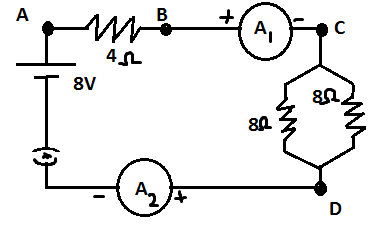
In the given circuit, how much power is dissipated from the 4 ohms resistor?

Option A: 4W
Option B: 2W
Option C: 1W
Option D: 6W
Answer
216.6k+ views
Hint: The ammeters will read the same current. They will read the total current in the circuit. Equivalent circuit will give you the total current.
Complete solution:
Power dissipated from a resistor is given as the product of the square of current flowing through it and the resistance of the resistor.
For the given problem, we must first calculate equivalent resistance of the circuit.
Here the two 8 ohms resistors are connected in parallel because the potential drop across the two is the same. Also their starting and ending points are the same as well.
So equivalent of the two 8 ohms resistors is given by;
$R' = \dfrac{{{R_1} \times {R_2}}}{{{R_1} + {R_2}}}$ (resistors in parallel)
Here both the resistors are of 8 ohms;
So, $R' = \dfrac{{8 \times 8}}{{8 + 8}} = \dfrac{{64}}{{16}}$
Hence, $R' = 4\Omega $
Now, the 4 ohms resistor and $R'$ are in series so equivalent resistance of the circuit is given by;
${R_{eq}} = 4 + R' = 4 + 4$
Hence ${R_{eq}} = 8\Omega $
Now with the help of the equivalent resistance we will find the total current in the circuit.
$I = \dfrac{V}{{{R_{eq}}}}$
Hence,$I = \dfrac{8}{8} = 1Amp$, this much current flows through the circuit.
Now this current will flow through the 4 ohms resistor, so, the power dissipated from the 4 ohm resistor is given by;
$P = {I_2}R$
$P = {1^2} \times 4 = 4W$
Hence 4W power will be dissipated from the resistor.
Therefore option A is correct.
Note:
(1) There is one more way of doing this problem, by finding the potential drop across 4 ohms.
(2) The other definition of power is the ratio of square of potential drop across the resistor to the resistance of the resistor.
Complete solution:
Power dissipated from a resistor is given as the product of the square of current flowing through it and the resistance of the resistor.
For the given problem, we must first calculate equivalent resistance of the circuit.
Here the two 8 ohms resistors are connected in parallel because the potential drop across the two is the same. Also their starting and ending points are the same as well.
So equivalent of the two 8 ohms resistors is given by;
$R' = \dfrac{{{R_1} \times {R_2}}}{{{R_1} + {R_2}}}$ (resistors in parallel)
Here both the resistors are of 8 ohms;
So, $R' = \dfrac{{8 \times 8}}{{8 + 8}} = \dfrac{{64}}{{16}}$
Hence, $R' = 4\Omega $
Now, the 4 ohms resistor and $R'$ are in series so equivalent resistance of the circuit is given by;
${R_{eq}} = 4 + R' = 4 + 4$
Hence ${R_{eq}} = 8\Omega $
Now with the help of the equivalent resistance we will find the total current in the circuit.
$I = \dfrac{V}{{{R_{eq}}}}$
Hence,$I = \dfrac{8}{8} = 1Amp$, this much current flows through the circuit.
Now this current will flow through the 4 ohms resistor, so, the power dissipated from the 4 ohm resistor is given by;
$P = {I_2}R$
$P = {1^2} \times 4 = 4W$
Hence 4W power will be dissipated from the resistor.
Therefore option A is correct.
Note:
(1) There is one more way of doing this problem, by finding the potential drop across 4 ohms.
(2) The other definition of power is the ratio of square of potential drop across the resistor to the resistance of the resistor.
Recently Updated Pages
Wheatstone Bridge Explained: Working, Formula & Uses

Young’s Double Slit Experiment Derivation Explained

JEE Atomic Structure and Chemical Bonding important Concepts and Tips

JEE Amino Acids and Peptides Important Concepts and Tips for Exam Preparation

Electricity and Magnetism Explained: Key Concepts & Applications

Chemical Properties of Hydrogen - Important Concepts for JEE Exam Preparation

Trending doubts
JEE Main 2026: Application Form Open, Exam Dates, Syllabus, Eligibility & Question Papers

Derivation of Equation of Trajectory Explained for Students

Hybridisation in Chemistry – Concept, Types & Applications

Understanding the Angle of Deviation in a Prism

Understanding Collisions: Types and Examples for Students

How to Convert a Galvanometer into an Ammeter or Voltmeter

Other Pages
JEE Advanced Marks vs Ranks 2025: Understanding Category-wise Qualifying Marks and Previous Year Cut-offs

Ideal and Non-Ideal Solutions Explained for Class 12 Chemistry

Degree of Dissociation: Meaning, Formula, Calculation & Uses

Understanding Electromagnetic Waves and Their Importance

Understanding the Electric Field of a Uniformly Charged Ring

Understanding Average and RMS Value in Electrical Circuits




